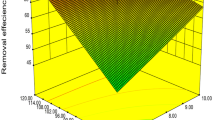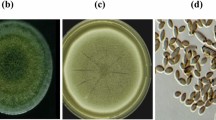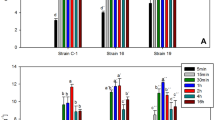Abstract
The Pb(II) and Ni(II) biosorption of a fungal biomass isolated from mine drainage of metal-processing industries in Balya (Balıkesir province, Turkey) was optimized using a response surface methodology by altering parameters such as pH, initial metal concentration, contact time and biosorbent dosage. This strain was shown to be highly similar to Penicillium sp. Furthermore, zeta potential measurements and Fourier transform infrared spectroscopy were performed to understand the adsorption mechanism. A Box–Behnken design with 29 experiments was used to evaluate the interactions between independent variables. The results showed that the fungal biomass isolated from the metal mine drainage could have a significant environmental impact through the biosorption of Pb(II) and Ni(II) in waters polluted with heavy metals, particularly in the drainage from metal mines. The maximum removal values were 76 and 47 % at pH 4.5 for both Pb(II) and Ni(II), with 123 and 33 mg/L initial metal concentrations, 65 and 89 min contact times and 0.2 and 1.6 g/L biosorbent, respectively.





Similar content being viewed by others
References
Akar T, Cabuk A, Tunali S, Yamac M (2006) Biosorption potential of the macrofungus Ganoderma carnosum for removal of lead(II) ions from aqueous solutions. J Environ Sci Heal A 41:2587–2606
Akar T, Tunali S, Çabuk A (2007) Study on the characterization of lead(II) biosorption by fungus Aspergillus parasiticus. Appl Biochem Biotechnol 136:389–485
Akar ST, Akar T, Kaynak Z, Anilan B, Cabuk A, Tabak Ö, Demir TA, Gedikbey T (2009) Removal of copper(II) ions from synthetic solution and real wastewater by the combined action of dried Trametes versicolor cells and montmorillonite. Hydrometallurgy 97:98–104
Amini M, Younesi H, Bahramifar N, Lorestani AAZ, Ghorbani F, Daneshi A, Sharifzadeh M (2008) Application of response surface methodology for optimization of lead biosorption in an aqueous solution by Aspergillus niger. J Hazard Mater 154:694–702
Amini M, Younesi H, Bahramifar N (2009) Biosorption of nickel(II) from aqueous solution by Aspergillus niger: response surface methodology and isotherm study. Chemosphere 75:1483–1491
Aslan N, Cebeci Y (2007) Application of Box–Behnken design and response surface methodology for modeling of some Turkish coals. Fuel 86:90–97
Azila YY, Mashitah MD, Bhatia S (2008) Process optimization studies of lead (Pb(II)) biosorption onto immobilized cells of Pycnoporus sanguineus using response surface methodology. Bioresour Technol 99:8549–8552
Baker BJ, Banfield JF (2003) Microbial communities in acid mine drainage. FEMS Microbiol Ecol 44:139–152
Baker BJ, Lutz MA, Dawson SC, Bond PL, Banfield JF (2004) Metabolically active eukaryotic communities in extremely acidic mine drainage. Appl Environ Microbiol 70:6264–6271
Barnett HL, Hunter BB (1998) Illustrated genera of imperfect fungi, 4th edn. APS Press, St. Paul, MN, p 218
Bhunia P, Ghangrekar MM (2008) Statistical modeling and optimization of biomass granulation and COD removal in UASB reactors treating low strength wastewaters. Bioresour Technol 99:4229–4238
Cabuk A, Akar T, Tunali S, Gedikli S (2007) Biosorption of Pb(II) by industrial strain of Saccharomyces cerevisiae immobilized on the biomatrix of cone biomass of Pinus nigra: equilibrium and mechanism analysis. Chem Eng J 131:293–300
Cerino Córdova FJ, García León AM, Garcia Reyes RB, Garza González MT, Soto Regalado E, Sánchez González MN, Quezada Lopez I (2011) Response surface methodology for lead biosorption on Aspergillus terreus. Int J Environ Sci Tech 8(4):695–704
Das BK, Roy A, Koschorreck M, Mandal SM, Wendt-Potthof K, Bhattacharya J (2009) Occurrence and role of algae and fungi in acid mine drainage environment with special reference to metals and sulfate immobilization. Water Res 43:883–894
De Rome L, Gadd GM (1987) Copper adsorption by Rhizopus arrhizus, Cladosporium resinae and Penicillium italicum. Appl Microbiol Biotechnol 26:84–90
Dursun AY (2006) A comparative study on determination of the equilibrium, kinetic and thermodynamic parameters of biosorption of copper(II) and lead(II) ions onto pretreated Aspergillus niger. Biochem Eng J 28:187–195
Elibol M (2002) Response surface methodological approach for inclusion of perflurocarbon in actinorhodin fermentation medium. Process Biochem 38:6767–6773
Feng Q, Lin Q, Gong F, Sugita S, Shoya M (2004) Adsorption of lead and mercury by rice husk ash. J Colloid Interface Sci 278:1–8
Fereidouni M, Daneshi A, Younesi H (2009) Biosorption equilibria of binary Cd(II) and Ni(II) systems onto Saccharomyces cerevisiae and Ralstonia eutropha cells: application of response surface methodology. J Hazard Mater 168:1437–1448
Gadd GM, White C (1989) Removal of thorium from simulated acid process steams by fungal biomass. Biotechnol Bioeng 33:592–597
Gazea B, Adam K, Kontopoulos A (1996) A review of passive systems for the treatment of acid mine drainage. Mineral Eng 9:23–42
Hafez N, Abdel-Razek AS, Hafez MB (1997) Accumulation of some heavy metals on Aspergillus flavus. J Chem Technol Biotechnol 68:19–22
Hallberg KB, Johnson DB (2001) Biodiversity of acidophilic microorganisms. Adv Appl Microbiol 49:37–84
Iskandar NL, Zainudin NAIM, Tan SG (2011) Tolerance and biosorption of copper (Cu) and lead (Pb) by filamentous fungi isolated from a freshwater ecosystem. J Environ Sci 23:824–830
Johnson DB, Hallberg KB (2005) Acid mine drainage remediation options: a review. Sci Total Environ 338:3–14
Kapoor A, Viraraghavan T (1997) Heavy metal biosorption sites in Aspergillus niger. Biores Technol 61:221–227
Kumar R, Singh R, Kumar N, Bishnoi K, Bishnoi NR (2009) Response surface methodology approach for optimization of biosorption process for removal of Cr(VI), Ni(II) and Zn(II) ions by immobilized bacterial biomass sp. Bacillus brevis. Chem Eng J 146:401–407
Kumar R, Bhatia D, Singh R, Bishnoi NR (2012) Metal tolerance and sequestration of Ni(II), Zn(II) and Cr(VI) ions from simulated and electroplating wastewater in batch process: kinetics and equilibrium study. Int Biodeter Biodegr 66:82–90
Limin D, Juan D, Xin B, Naili Y, Chunhui F, Ying Z (2009) Mechanism of Pb(II) biosorption by Saccharomyces cerevisiae. Int Conf Environ Sci Inf Appl Technol 1:712–715
Montgomery DC (2005) Design and analysis of experiments, vol 425, 6th edn. Wiley, New York, pp 394–395
Penreath RJ (1994) The discharge of waters from active and abandoned mines. In: Hester RE, Harrison RM (eds) Mining and its environmental impact. Issues in environmental science and technology no. 1. Royal Society of Chemistry, Herts, UK, pp 121–132
Pitt JI, Hocking AD (2009) Fungi and food spoilage, 3rd edn. Springer, Dordrecht
Qu Y, Li H, Li A, Ma F, Zhou J (2011) Identification and characterization of Leucobacter sp. N-4 for Ni(II) biosorption by response surface methodology. J Hazard Mater 190:869–875
Samson R, Hoekstra E, Frisvad J, Filtenborg O (2002) Introduction to food- and airborne fungi. The Netherlands, Central Bureau Voor Schimmelcultures, Utrecht
Sheoran AS, Sheoran V (2006) Heavy metal removal mechanism of acid mine drainage in wetlands: a critical review. Miner Eng 19:105–116
Ugulu I, Dogan Y, Baslar S, Varol O (2012) Biomonitoring of trace element accumulation in plants growing at Murat Mountain. Int J Environ Sci Tech 9(3):527–534
Volesky B, Holan ZR (1995) Biosorption of heavy metals. Biotechnol Prog 11:235–250
Wang XS, Huang J, Hu HQ, Wang J, Qin Y (2007) Determination of kinetic and equilibrium parameters of the batch adsorption of nickel(II) from aqueous solutions by Na-mordenite. J Hazard Mater 142:467–468
Watanabe T (2002) Trichoderma harzianum: pictorial atlas of soil and seed fungi morphologies of cultured fungi and key to species, 2nd edn. CRC Press, New York
White T, Bruns T, Lee S, Taylor J (1990) Amplification and direct sequencing of fungal ribosomal RNA genes for phylogenetics. In: Innis MA, Gelfand DH, Sninsky JJ, White TJ (eds) PCR protocols: a guide to methods and applications. Academic Press, Inc., New York, pp 315–322
Acknowledgments
The authors are grateful to the Forest, Soil and Ecology Research Institute of the Ministry of the Environment for metal analyses. We thank Dr. Semra İlhan and Ercin Kocabiyik for their support for the molecular identification of the fungal isolate used in this study. We thank Molecular Synthesize and FT-IR Spectroscopy Research Laboratory at Eskisehir Osmangazi University. The abstract of this study was sent to The 15th European Congress on Biotechnology and the only abstract was published in New Biotechnology.
Author information
Authors and Affiliations
Corresponding author
Rights and permissions
About this article
Cite this article
Aytar, P., Gedikli, S., Buruk, Y. et al. Lead and nickel biosorption with a fungal biomass isolated from metal mine drainage: Box–Behnken experimental design. Int. J. Environ. Sci. Technol. 11, 1631–1640 (2014). https://doi.org/10.1007/s13762-013-0354-5
Received:
Revised:
Accepted:
Published:
Issue Date:
DOI: https://doi.org/10.1007/s13762-013-0354-5




